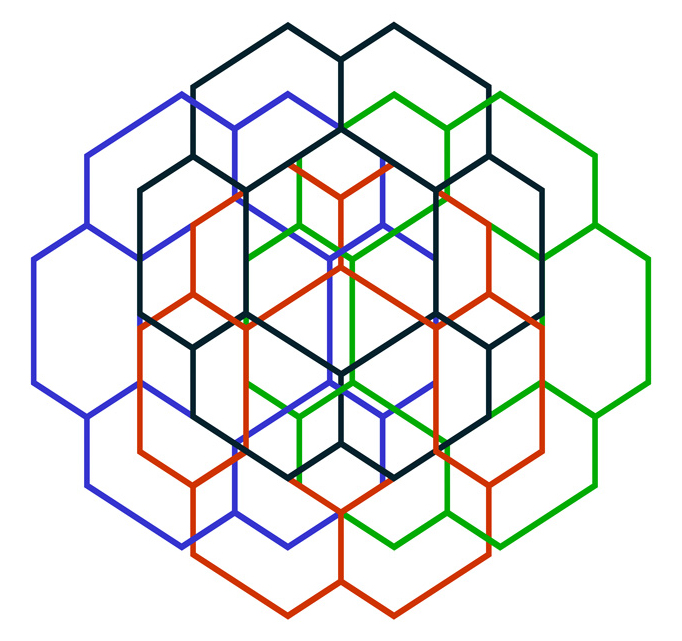בשתי היצירות: "הצופן המפורק" (1997) ו"ביו-משושים" (2002-2000), בוחן האמן כיצד אפשר לפתח מאותו מארג משושה צורות גיאומטריות ובו-בזמן גם צורות אורגניות, ובכך לסתור את הדעה הרווחת על הניגוד הבסיסי הקיים ביניהן. סוגייה זו העסיקה כבר את האמנות האסלאמית הקדומה, אשר שילבה מוטיבים של צמחים בתוך מארגיה הגיאומטריים. קית קריצ'לו (Keith Critchlow), אשר חקר את המארג האסלאמי, מבהיר את יסודות הגישה: "אמנות האסלאם היא, בראש ובראשונה, איזון בין צורה גיאומטרית טהורה לבין מה שניתן לכנותו צורה ביומורפית בסיסית, כלומר קיטוב בעל ערכים המתקשרים לארבע התכונות הפילוסופיות והחווייתיות: קור ויובש – המייצגות את ההתגבשות בצורות גיאומטריות, וחום ולחות - המייצגות את כוחות הצמיחה העומדים ביסודן של צורות הצומח והחי". שיטת המארג מאפשרת לברמן-קדים להדגים איך מאותו מודול המשושה מתפתחות צורות גיאומטריות ואורגניות שבו בזמן מתעמתות ומשתלבות זו עם זו.
תכונות המשושה התאימו במיוחד למארג האסלאמי. "מבחינה גרפית," מסביר קריצ'לו, "המשושה הוא הצורה הטבעית ביותר, בעלת צלעות ישרות הנוצרות באמצעות חלוקות שוות של היקף המעגל... המשולש שווה הצלעות, המשושה והריבוע הן שלוש צורות היסוד הגיאומטריות היכולות ליצור משטח רציף בלי להותיר בו מרווחים. לכל אחת מהצורות הללו התנהגות טיפוסית משלה, המוגדרת הן במונחיה העצמיים של הצורה והן בדרכים שונות במסגרת המבנה הבסיסי שלה. המשושה, על שש פאותיו, יכול לפתח מארגים שונים, גדולים או קטנים יותר, באמצעות תיחום כל נקודה בתוך מצולע קטן יותר, כך שלכל מצולע יש צלע משותפת עם המצולע השכן: כך נוצרת מערכת היכולה לגדול או להתכווץ באורח אינסופי".
In his works: "Hexagons: The Code Dismantled" (1997) and "Bio Hexagons" (2000-2002), the artist examins how from the one hexagonal pattern, it is possible to simultaneously develop both geometric forms and thus to contradict the prevalent view about the basic opposition. This problem had already engaged Islamic art, which incorporated plant mou geometric patterns. Critchlow elucidates the elements of the Islamic a d. 1997 and Bio from the one hexagonal both geometric forms and organic forms, basic opposition existing between them. incorporatedated plant motifs within its the Islamic approach: "Islamic art form and what can be called associative values with the four is predominantly a balance between pure geometric fundamental biomorphic form: a polarization that has associative value philosophical and experiential qualities of cold and dry - representing the crystallization in geometric form - and hot and moist - representing the formative forces behind vegetative and vascular form. The pattern method enables Berman-Kadim to demonstrate how geometric and organic forms that simultaneously confront and integrate with one another can develop from the one hexagonal module.
The properties of the hexagon were especially appropriate to the Islamic pattern. Keith Critchlow, who studied the Islamic pattern, explains this fact: "... the hexagon is graphically the most natural shape with straight line edges produced by equal divisions of the circumference of the circle. ... the equilateral triangle, the hexagon and the square are the three primary shapes which will independently fill a surface without leaving gaps. Each shape has its own archetypal behavior in terms of itself and also within its own matrix. Hexagons with their 'Sixness' and six-sidedness can develope a smaller or larger patterns by surrounding each point and with a smaller similar figure so that each has a common edge with its neighbor: this implies an indefinitely small and large growth system".











